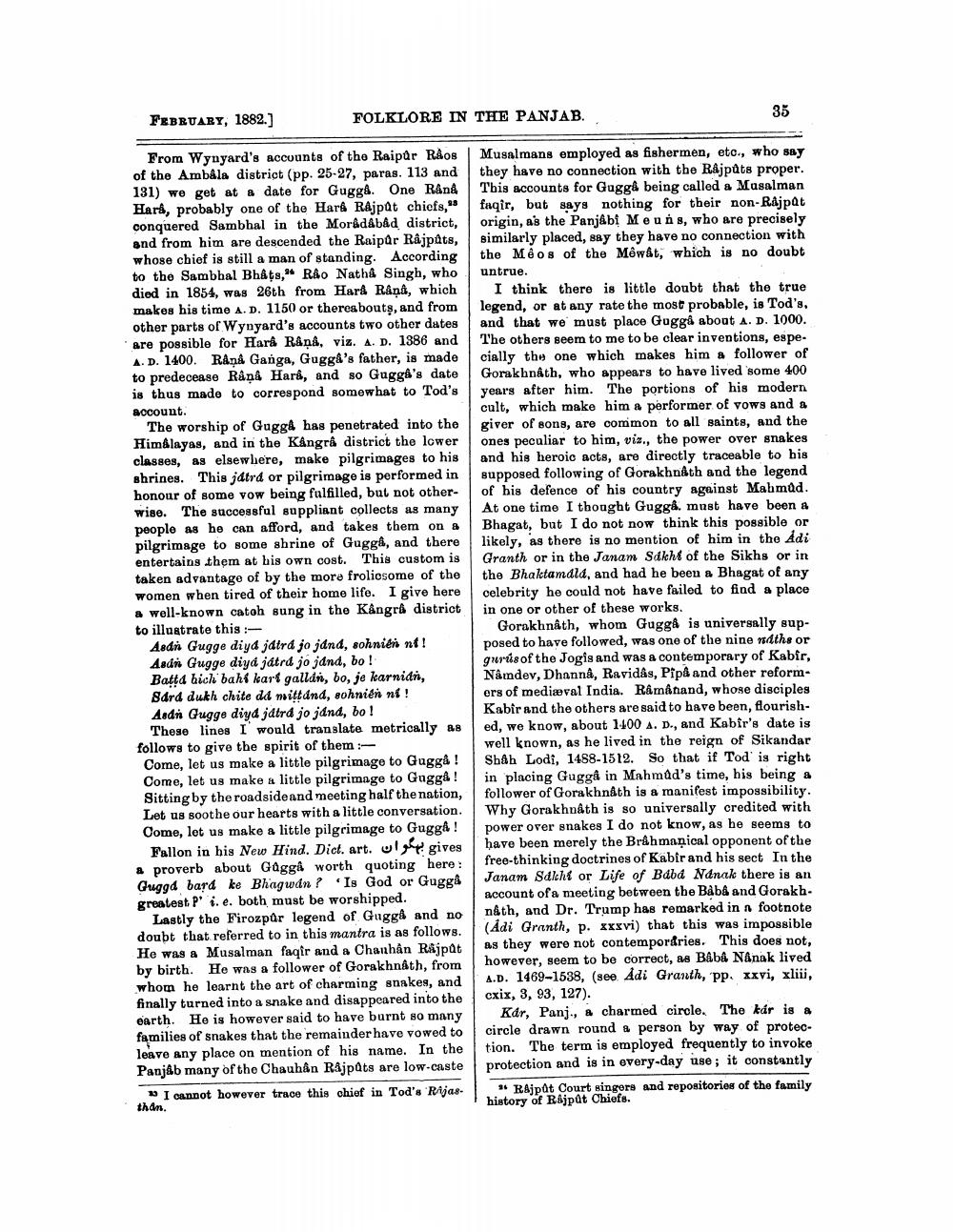________________
FEBRUARY, 1882.]
FOLKLORE IN THE PANJAB.
From Wynyard's accounts of the Raipur Raos of the Ambåla district (pp. 25-27, paras. 113 and 131) we get at a date for Gugga. One Rank Hara, probably one of the Harh Rajput chiefs, conquered Sambhal in the Moradabad district, and from him are descended the Raipar Rajpats, whose chief is still a man of standing. According to the Sambhal Bhâts," Rao Natha Singh, who died in 1854, was 26th from Harå Råņa, which makes his time A.D. 1150 or thereabouts, and from other parts of Wynyard's accounts two other dates are possible for Harå Rånå, viz. A. D. 1386 and A.D. 1400. Rånå Ganga, Guggå's father, is made to predecease Råņå Hara, and so Gugga's date is thus made to correspond somewhat to Tod's account.
The worship of Gugg& has penetrated into the Himalayas, and in the Kångra district the lower classes, as elsewhere, make pilgrimages to his shrines. This jdtrd or pilgrimage is performed in honour of some vow being fulfilled, but not otherwise. The successful suppliant collects as many people as he can afford, and takes them on a pilgrimage to some shrine of Gugge, and there entertains them at his own cost. This custom is taken advantage of by the more froliosome of the women when tired of their home life. I give here a well-known catch sung in the Kångra district to illustrate this :
Asdn Gugge diyd jdtrd jo jdnd, sohniên nf ! Asdi Gugge diyá játrd jo jdnd, bo ! Batta bich bahí kart galldn, bo, je karnidh, Sdrd dukh chite da mittand, sohniên ni! Asdn Gugge diya jatra jo jánd, bo!
These lines I would translate metrically as follows to give the spirit of them :Come, let us make a little pilgrimage to Gugg& ! Come, let us make a little pilgrimage to Gugg& ! Sitting by the roadside and meeting half the nation, Let us soothe our hearts with a little conversation. Come, let us make a little pilgrimage to Gugg!
Fallon in his New Hind. Dict. art. ulghe gives a proverb about Gagga worth quoting here : Guggd bard ke Bhagwan ? Is God or Gugg& greatest P' i.e. both must be worshipped.
Lastly the Firozpur legend of Gugga and no doubt that referred to in this mantra is as follows. He was a Musalman faqir and a Chanhân Rajpat by birth. He was a follower of Gorakhnath, from whom he learnt the art of charming snakes, and finally turned into a snake and disappeared into the oarth. He is however said to have burnt so many families of snakes that the remainder have vowed to leave any place on mention of his name. In the Panjab many of the Chauhan Rajpats are low-coste
I cannot however trace this chief in Tod's Rijasthan.
Musalmans employed as fishermen, etc., who say they have no connection with the Rajpats proper. This accounts for Gugg& being called a Musalman faqir, but says nothing for their non-Rajpat origin, as the Panjabi Meuns, who are precisely similarly placed, say they have no connection with the Meos of the Mêwat, which is no doubt untrue.
I think there is little doubt that the true legend, or at any rate the most probable, is Tod's. and that we must place Guggå about A. D. 1000. The others seem to me to be clear inventions, espe. cially the one which makes him a follower of Gorakhnath, who appears to have lived some 400 years after him. The portions of his modern cult, which make him a performer of vows and a giver of sons, are common to all saints, and the ones peculiar to him, viz., the power over snakes and his heroic acts, are directly traceable to his supposed following of Gorakhnath and the legend of his defence of his country against Mahmud. At one time I thought Gugga. must have been a Bhagat, but I do not now think this possible or likely, as there is no mention of him in the Adi Granth or in the Janam Sakht of the Sikhs or in the Bhaktamdld, and had he been a Bhagat of any celebrity he could not have failed to find a place in one or other of these works.
Gorakhnath, whom Gugg& is universally supposed to have followed, was one of the nine naths or gurus of the Jogis and was a contemporary of Kabir, Nåmdev, Dhanna, Ravidas, Pipâ and other reformers of mediæval India. Ramanand, whose disciples Kabir and the others are said to have been, flourished, we know, about 1400 A. D., and Kabir's date is well known, as he lived in the reign of Sikandar Shah Lodi, 1488-1512. So that if Tod' is right in placing Gugga in Mahmud's time, his being a follower of Gorakhnath is a manifest impossibility. Why Gorakhnath is so universally credited with power over snakes I do not know, as he seems to have been merely the Brahmaņical opponent of the free-thinking doctrines of Kabir and his sect In the Janam Sakhi or Life of Baba Nanak there is an account of a meeting between the Babâ and Gorakh. náth, and Dr. Trump has remarked in footnote (Adi Granth, p. xxxvi) that this was impossible as they were not contemporfries. This does not, however, seem to be correct, as Bâbâ Nának lived A.D. 1469-1538, (see Adi Granth, pp. xxvi, xliii, cxix, 3, 93, 127).
Kar, Panj., a charmed circle. The kár is a circle drawn round & person by way of protection. The term is employed frequently to invoke protection and is in every day use; it constantly
" RAipùt Court singers and repositories of the family history of Rajput Chiefs.




